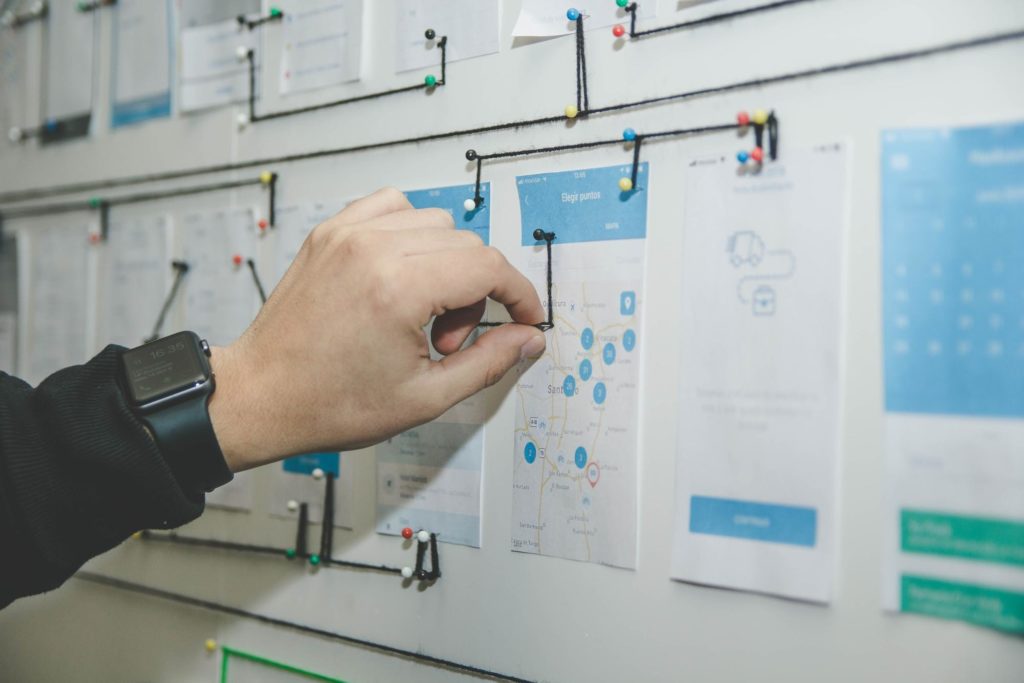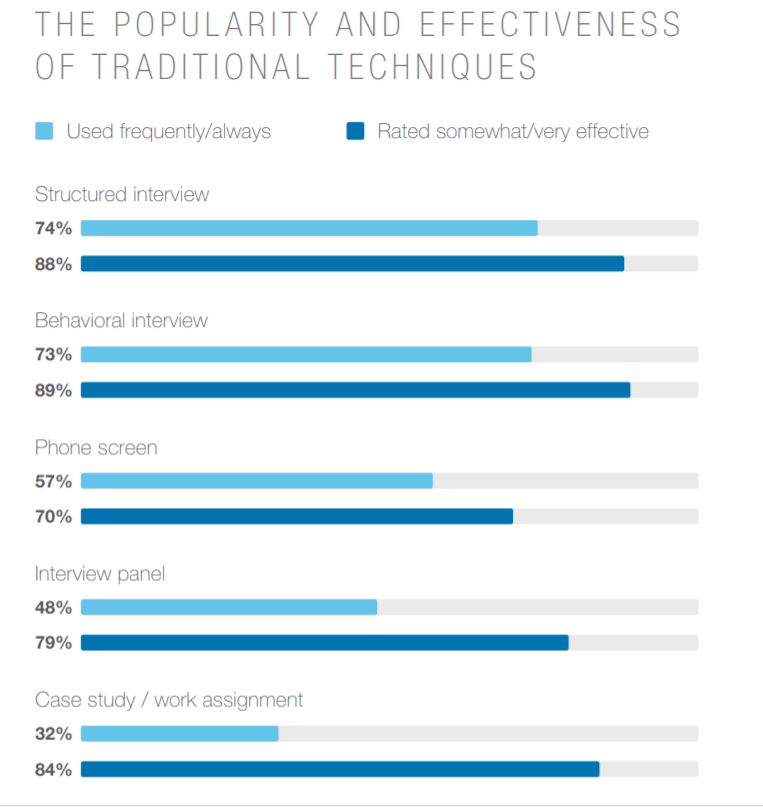
Job Interview Skills and Techniques For Employers

Job interviews are the first point of the interview process where you can start piecing things together. And by using specific interview techniques and skills, you’re able to shed a little more light on your applicant.
An interview gives you, the interviewer, the first real chance to assess a person and see if they’re an OK fit or a bad fit for the applied position. But your interviewing skills and techniques are more than what you say – it’s your body language, the environment and the way that you listen.
Interview Skills, Tools And Techniques
In this article, you’ll see:
- The best interview methods, skills, and techniques for employers
- How to create different types of interviews for certain positions
- How to interview for a job using behavioral questions
Using the following interview techniques for employers, you’ll be able to learn more about your applicants. Many of these interviewing tips will speed up the recruitment process and help you assess a candidate on their job skills, not just how well they sit an interview.
Please note that if you’re looking for technical interview tips, you can find them in this post: How to give a technical interview: 7 technical interview tips or if you are looking for more, check out The ultimate guide to the technical interview.
Now, let’s dive into our collection of interview techniques.
Interview tip #1 – Know the position in the company
Before you get too involved with these job interview skills and techniques, you need to be sure you know as much as you can about the exact position in the company that you’re hiring for.
Of course, you know the position you’re hiring for, but what about that same position at your company? This involves knowing the role that your company culture plays in this specific position as well as all positions.
Spend some time with the co-workers and managers of the position you’re hiring for and get to know the team. Does your dev team work in a sprint, or is each person delegated tasks by a manager? The skills a Java developer has may be consistent no matter which company they work for, but consider the things that make your company unique. A good interview technique is to describe the position in the company, not just the standalone position.
Recommended reading:How to make a job ad that no developer can resist
Interview technique #2 – Screen out non-viable candidates before the first interview
Having too many interviews, especially with candidates who don’t meet the criteria, puts unnecessary strain on the entire HR department. In the case of tech roles, it also puts pressure on the tech leads or developers responsible for running technical interviews.
An efficient, automated technical screening platform allows you to preselect candidates before inviting them to an interview. This way, you make sure everyone you devote your face-to-face time to has the technical skills defined in the job description.
Take a look at how Spartez decreased their number of interviews:
Source: DevSkiller
Their results were excellent:
- increased interviewer satisfaction by 40% (less work for everyone!)
- 44% more candidates filtered out before the first interview
- a decrease in the number of candidates who reach the technical interview by 8.6 times
To achieve this, Spartez did two things:
- Swapped their in-house solution IAN for DevSkiller
- Changed the order of their recruitment process steps
Read their full story here.
Interview tip #3 – Structure the interview correctly
The most important interview skills and techniques revolve around the way you structure the interview. It mightn’t be too constructive to introduce yourself, then ask the applicant some questions, and finally outline the position they’ve applied for.
A good recruiter will have a set structure to the interview, but can still conduct an interview in a dynamic way. Great interview techniques like this will help you hold an interview that flows naturally but also covers all areas that it needs to.
Here’s a great general outline:
- Small talk
- Outline today’s interview and the recruitment process in your company
- Introduce the position and ask if there any questions
- Discuss CV and cover letter
- Ask behavioral interview questions
- Set any tests or tasks to be completed in the interview – in the case of tech roles, the technical interview is typically scheduled to take place right after the soft skills interview so the candidate doesn’t have to travel twice to take two interviews
- Let the applicant ask any final questions about the position or recruitment process
- Summary & conclusion – tell the applicant when they’ll hear from you next
Remember that this is by no means a set structure. Use it as an outline. Swap areas around for different job positions, or to see if you can learn more about applicants.
In most companies, the soft skills interview is followed by a technical interview.
Recommended reading: How to give a technical interview – 7 tips
Interview skill #4 – Interviews work two ways
Most interview techniques involve you assessing the applicant. But the interview is as just as much the applicant assessing the position and the company.
 As a result, you may also find yourself ‘selling’ the position to the applicant. Yes, the applicant has applied, but they mightn’t know everything about your company – you can only find out so much from a careers page. It’s pretty standard for an applicant to ask some questions during the interview process, so be prepared to answer them.
As a result, you may also find yourself ‘selling’ the position to the applicant. Yes, the applicant has applied, but they mightn’t know everything about your company – you can only find out so much from a careers page. It’s pretty standard for an applicant to ask some questions during the interview process, so be prepared to answer them.
These may be HR-related or more specifically suited to the position on offer. If you don’t know an answer, say so, then take a mental note, and be sure to follow up with it.
Some applicants may have no questions, some may be overflowing with questions. Your interview techniques should allow for on the spot questions, as well as giving the applicant dedicated time to ask questions and receive answers.
Of course, answer these questions honestly but also take note of the questions asked, as they may give you a little insight into the concerns and apprehensions of the applicant.
Interviewing tip #5 – Know the candidate
Everyone is busy, but you’re going to look bad and won’t work efficiently if you don’t know anything about the person you’re interviewing.
 On the morning of the interview before anyone arrives, sit down and reread the CVs and/or cover letters of the applicants you’ll be meeting that day. If you’re unsure how to interview for a job, learning a little about the person you’re interviewing is a good place to start.
On the morning of the interview before anyone arrives, sit down and reread the CVs and/or cover letters of the applicants you’ll be meeting that day. If you’re unsure how to interview for a job, learning a little about the person you’re interviewing is a good place to start.
You mightn’t be able to commit all faces to names, but you’ll at least be able to start to associate certain skills and achievements to certain candidates. Highlight parts of the CV that you want to discuss and perhaps even form some specific behavioral questions around them.
When you can do this, your interview will flow smoother and you’ll learn more about your candidate in a smaller amount of time.
Interview technique #6 – Start with small talk & get them relaxed
Many interviewers often forget that the person they’re interviewing may very well become their co-workers in the future. Different types of interviews may call for different interview techniques, but generally, a little small talk never hurts. In fact, advancing your conversational skills is probably one of the best places to start when it comes to the best interview skills and techniques.
 Avoid weather and traffic and try not to go into the story of how the company started, but something like ‘did you find the place ok?’ can ease up your applicant.
Avoid weather and traffic and try not to go into the story of how the company started, but something like ‘did you find the place ok?’ can ease up your applicant.
Here are some other small talk ideas:
- ‘What are you doing to pass the time since you’re not currently employed?’
- ‘We having a company-wide argument – tea or coffee, which do you prefer?’
- ‘I noticed on your LinkedIn profile that you volunteer at the pet shelter I got my cat from’
Small talk has the added benefit of making your applicant feel welcomed and relaxed. Just remember not to get too caught up in it, or you may form an unconscious bias toward someone who you personally get along with! You’re conducting an interview, not making friends!
Interview skill #7 – Explain the interview process
…and be sure your candidate knows the whole recruitment process.
Before you start throwing questions at your applicant, employers can use this following interview technique to put their applicant’s curious mind at ease. Begin by outlining what will happen in the interview:
- Is the interview a simple back and forth conversation?
- Will they be given any on the spot tests?
- Are they going to meet any other employees on that day?
Make all this known at the very start so that the applicant knows what to expect. These interview techniques give you the opportunity to tell the applicant the entire recruitment process.

Should you be happy (or unhappy) with the interview today, what happens next? Are there different types of interviews? Is there another interview or is it simply ‘we’ll let you know by the end of the week’? At the very least, mention it to the applicant before at the start of the first interview.
Find out how to CodePair remotely.
Interview method #8 – Know the most relevant questions to ask
As an interviewer, most of your interview techniques are based on asking questions. But the key to success is in how you ask a question.
‘Would you consider yourself resourceful in previous jobs?’
Yes and no questions are quite constraining, the responses aren’t overly insightful. Ask only open-ended behavioral questions that need a detailed answer.
‘Give me an example of a time you’ve been resourceful.”
This is a much better way to ask the previous question. It’s an interviewing tip that promises a response that’s relevant to the position. This technique gives you a good insight into the applicant’s creativity, and their ability to think on the spot.
Your interview technique may revolve around opening the same opened ended questions to everyone, but think on your feet and ask follow-up questions relevant to the previous answer.
Interview tip #9 – Use behavioral questions
What are behavioral questions?
Behavioral questions are questions based on the assumption that past behavior is an indication of future behavior.
‘Tell me about a time’ interview questions are a typical example of a behavioral question.
Behavioral questions are in essence, open-ended questions that throw the applicant into a situation where they must think about their past behavior. Using this interviewing technique and the above example of resourcefulness, you could ask a question like:
‘Give me an example of a time you’ve been resourceful in your previous job’.
One other benefit of asking behavioral questions is the fact that you can gauge the applicant’s enthusiasm and passion to answer well. One can make solving a mundane coding bug quite eloquent if it’s described in a certain way.
Note that behavior questions can be relevant to job-specific skills (when did you last use Python in a way you hadn’t done so before), as well as personality-specific questions (when were you last pushed to your limits and couldn’t handle it?).
Interview method #10 – Pay attention to body language
A valuable employer interview technique is to assess non-verbal queues. Actions speak louder than words, as the old saying goes.
Someone that’s a little too relaxed in your interview may consider the position ‘below’ them. Is your applicant making constant eye contact and using their hands to speak, or are their tied up and avoiding eye contact completely?

Your ideal candidate is someone who verbally and non-verbally engages with you, the interviewer, and isn’t off on another planet. Smaller actions like leaning forward as you speak and crossed legs toward you are other ways you can tell an applicant is interested.
But remember that someone who interviews terribly may still be a fantastic fit for the role advertised. Fast speaking, mixed up words and the jitters are completely normal. Similarly, the best interviewee may nail your interview but have the worst skills and experience.
Interview skill #11 – Actually listen
One of the most overlooked employers interviewing tips is the ability to listen. Many interviewers focus so much on the next question that the often forget to actually consume and digest what their applicant says.
In order to listen well, you need to focus and concentrate on what the applicant is actually saying. Check out their word choice, sentence structure and if they’re implying something with a specific response.
These are little nuances that you can only pick up on if you’re truly listening to your candidate. It’s little interview techniques like this that can help you build a more full picture of all applicants.
Interview technique #12 – Stay focused on what’s important
From time to time, you’re going to come across candidates who you just ‘click’ with. You all get along very well. These are people that you won’t need to try to make small talk with and that you’ll easily get distracted and go deep into other topics about.
The same thing may happen even when you’re on topic. For example, you may spend a significant amount of time discussing previous employment history, when what’s more important to you is to ask your behavioural questions.
This isn’t a bad thing, but it’s not what’s important, and it’s not what a job interview is about. A good interview technique is being able to identify when the conversation is starting to go off topic and to bring it back.
Interview method #13 – Soft skills = personal skills
According to a recent report, traditional interview techniques overlook skills and abilities that are integral to the way we work in the modern world – whether it be a small business, large corporation or a startup.

Source: LinkedIn
One of the things that we overlook is soft skills. These are things like teamwork, flexibility and the underpinning knowledge of many niche-talents.
So how do you assess an individual’s soft skills?
There are many high-tech tools that involve problem solving and neuroscience to grade the flexibility of one’s soft skills. If that’s a little too much for you, ask some behavioral based questions about if and how their work skills can be applied in their personal life.
By using these interview techniques to assess someone’s soft skills, you get a bigger and more detailed snapshot of a candidates personality. Furthermore, you may also find that someone who has less experience is just as good a fit as someone with years of experience.
Interview skill #14 – Job interviews only show an individual’s interview skills
If you’re holding an interview for a middle-level Java developer, there’s only so much insight that an interview can bring. The job description might say that you need someone who is creative when it comes to bug fixes – but how will a sit-down, face to face interview solve that problem?
Job interviews are a great way of getting to know someone, but they’re inherently terrible as assessing specialist skills. A job interview only gives you insights on the interview skills of that individual.
So how do you solve this problem?
Well, if you’re looking to hire developers, we have an extensive coding test catalog of coding tests you can use. These tests give your applicant access to job-specific code, without the ability of them messing up an actual product. These tests can be done at any point – during the interview, before it or afterwards.
Interview techniques for employers: Conclusion
So there you have our collection of interview techniques for employers. If you’re not sure how to be a good interviewer, using the skills and methods listed above are a great place to start. By using these interview strategies as elements of every interview that you sit, you’ll start to save time, build a better picture of your applicants and fill more positions with the best candidates





